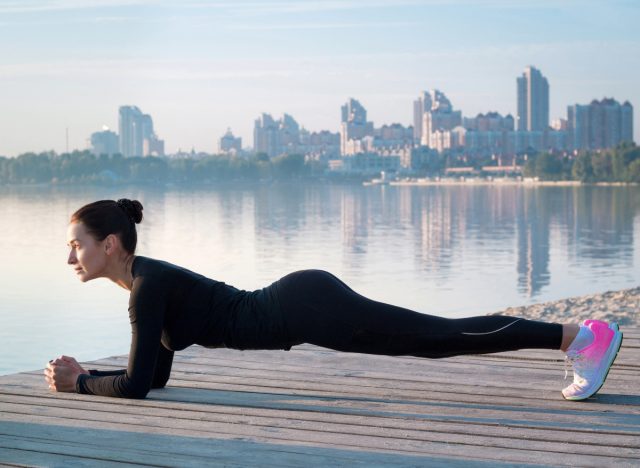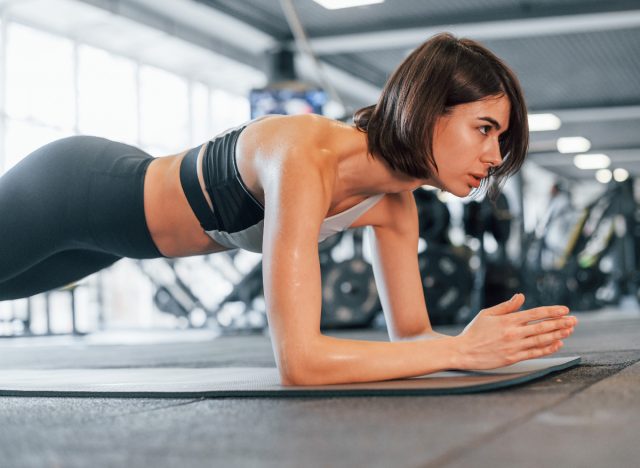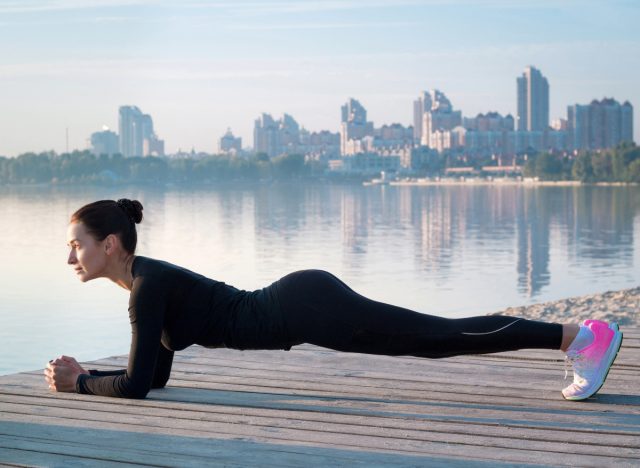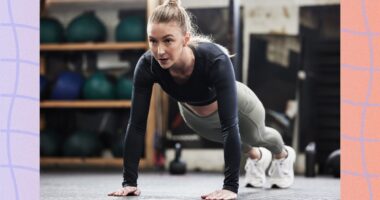Just about everyone dreams of having a slim, defined core. But let’s face it: Endless sit-ups can feel like a chore and become mundane. Conversely, planks inject excitement and effectiveness, paired with a new-found challenge you’ve been looking to add to your workouts. This deceptively simple exercise might be the game-changer you need in your workouts, and I’m here to break down how to do planks for a slimmer core and the best variations.
At first glance, the idea of just holding still might not seem like it could make you stronger and slimmer. But the magic of the plank lies in its simplicity and effectiveness. By engaging multiple muscle groups simultaneously, planks provide a workout targeting your core and call upon other muscle groups to provide much-needed support. (Shout out to your shoulders and glutes!)
Whether you’re a fitness newbie or a seasoned gym-goer, incorporating planks into your routine can help you build a stronger, more resilient core while burning calories. Let’s dive into the power of planks, the correct way to do them, the optimal duration to hold the position for the best results, and why we’re at it.
How do planks strengthen and slim down your core?


Planks are one of the most efficient exercises for targeting the core. When you hold a plank, you’re not just working your abs. This static exercise engages your entire body, from your shoulders to your toes.
Maintaining a stable position activates the deep stabilizing muscles in your core, including the transverse abdominis, rectus abdominis, and obliques. These muscles are essential for maintaining proper posture and supporting your spine.
However, the benefits of planks extend beyond muscle activation. Holding a plank position burns calories, which helps reduce body fat over time. Since you’re engaging multiple muscle groups, your body works harder to maintain the position, increasing calorie expenditure. Additionally, planks can boost your metabolic rate, so you’ll continue to burn calories after your workout.
See also 10 Best Bodyweight Exercises for Back Fat
Moreover, planks improve your overall strength and stability. A strong core is crucial for everyday activities and can enhance your performance in other exercises and sports. Regularly practicing planks will build a solid foundation to prevent injuries and improve balance and coordination. So, not only will you look great, but you’ll also feel stronger and more capable in your daily life activities.
How to perform a plank:
Getting into a proper plank position is critical to reaping this powerful exercise’s benefits.
Start by getting down on all fours, aligning your shoulders directly over your wrists. Step your feet back one at a time, extending your legs so your body forms a straight line from your head to your heels. Your feet should be about hip-width apart, and your hands should be shoulder-width apart. If you opt for a forearm plank, follow these guidelines, but keep your shoulders over your elbows and your hands directly out front.
Next, engage your core by pulling your belly button towards your ribcage. (I like to call this “tucking your belt buckle to your chest.”) This action will help keep your back flat and prevent your hips from sagging or lifting too high. Imagine a straight line running from the top of your head to your heels, and aim to maintain this alignment throughout the exercise. Keep your neck neutral by looking down at the floor, not letting your head droop or tilt upward.
Hold this position while breathing steadily. If you’re new to planking, you might start by holding it for 20 to 30 seconds, gradually increasing the duration as you build strength. It’s essential to focus on maintaining proper form rather than how long you can hold the plank. Incorrect form can lead to strain or injury, so take your time to perfect your technique.
See also 11 Best ‘Arm Day’ Exercises, According to a Trainer
As you become more comfortable and your core strengthens, you can extend your plank time, try different variations, and experience even greater benefits.
How long to hold it:


When it comes to holding a plank, quality trumps quantity. While it might be tempting to aim for several minutes off the bat, it’s more important to focus on maintaining correct form.
Starting with short intervals—such as 20 to 30 seconds—can be highly effective for beginners. As you build your strength and endurance, you can gradually increase the duration to one minute or longer.
Here’s a coaching tip: If you want to work your way to a minute-long plank or more, split this time into multiple sets with minimal rest periods. For instance, three sets of 20-second hold with 10 seconds in between is a great starting point.
For more advanced lifters, holding a plank for up to two minutes is often considered a good benchmark for core strength. However, rather than simply extending the time, you can also vary your plank routine to keep it challenging and engaging. Try incorporating side planks, plank variations like forearm planks, or dynamic movements like plank jacks to target different muscle groups and add intensity.
Remember, the key to progress is consistency. Planking every day or including it as part of your regular workout routine will yield the best results. Listen to your body and avoid overexertion. If you experience discomfort or strain, take a break and adjust your form.
The best variations:
Switching up your plank routine with variations keeps your workouts exciting and targets different muscle groups more effectively. These exercises can make your workouts fresh and fun, help slim down your core even more, and fit seamlessly into any workout: HIIT, strength training, cardio, or endurance.
See also The #1 Daily Workout To Build Shoulder Strength & Boost Mobility
Here’s a list of my favorite plank variations:
- Plank with shoulder taps
- Side plank
- Side plank with hip dips
- Side plank with leg lifts
- Plank jacks
- Three-point plank (single-leg)
- Extended arm plank
- TRX plank
- Copenhagen plank
Look to switch up your plank routine every four to six weeks. Another piece of advice is to use different plank variations throughout the week, focusing on different muscle groups and varying methods (static planks vs. dynamic planks).











